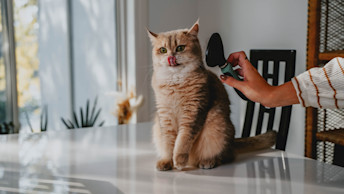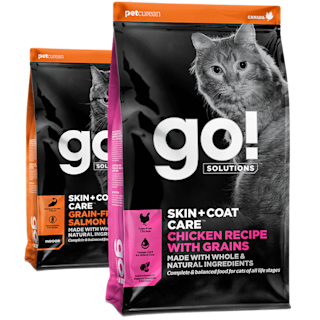September 18, 2023
Essential Nutrients for Skin + Coat Health for Cats

Skin and coat health is affected by many things, including genetic, dietary, and environmental factors. This article will focus on two dietary components; fatty acids and minerals, which both play key roles in maintaining healthy skin and a shiny coat.
Let’s start with fatty acids, which are the building blocks of fat. There are two categories that contain essential fatty acids, essential meaning that cats require from their diet. These are omega-6 and omega-3. In addition, specific minerals including zinc, manganese, iron and copper play key roles in cat skin and coat health.
Fatty Acids
In pet food, fatty acids can be obtained from many different ingredients, including plant and animal sources. When looking to support skin and coat health, it is important to consider not only the total amount of omega-6 and omega-3 fatty acids but also the ratio of omega-6 and omega-3.
When digested, omega-6 fatty acids are metabolized into substances which are known to be more inflammatory than omega-3s, therefore this ratio is important because too much dietary omega-6 and not enough omega-3 can contribute to a chronic state of low-grade inflammation. Inflammation in the body is associated with number of disease states, including some skin disorders1 and even obesity. Alternatively, too much dietary omega-3 can cause issues, such as reduced blood clotting efficiency, so, as with many things when it comes to nutrition, while some is good, more is not necessarily better, it’s all about balance!
Omega-6
Certain omega-6 fatty acids play a critical role in skin health by maintaining the outermost water barrier of the skin, namely linoleic acid. Linoleic acid is an essential omega-6 fatty acid for cats, since they must obtain it from their diet and cannot make it on their own. Chicken fat and canola oil are rich sources of linoleic acid.
Omega-3
Omega-3s are a group of polyunsaturated fatty acids which play numerous roles in the body. There are three omega-3 fatty acids that play particularly important roles in supporting your cat’s health: alpha-linolenic acid (ALA), eicosapentaenoic acid (EPA), and docosahexaenoic acid (DHA).
DHA and EPA support proper brain and eye development, which make them key to healthy kitten growth. All three of these fatty acids are essential in growing kittens. ALA is rich in oils from plants, such as flaxseed and canola oil. EPA and DHA are found only in marine sources, such as salmon and marine microalgae oil. Omega-3 fatty acids are known to be anti-inflammatory in nature, which can support healthy skin, and growth of a healthy coat.
Omega-3 fatty acids are known to be anti-inflammatory in nature, which can support healthy skin and the growth of a healthy coat.
Minerals
In general, minerals play many important functions in the body, including skin and coat health, proper bone and tissue development. These compounds are considered essential in the diet as the body cannot make them on their own and they are needed for proper functioning. Specific to skin and coat health are the key minerals zinc, manganese, iron and copper, each has specific roles in support healthy skin, coats, noses, and paws.
Zinc
As a key player in cellular growth and protein synthesis, zinc is integral in the support of healthy noses and paws, skin, and coats. Additionally, zinc plays a role in the development of a full coat. In fact, zinc is one of the most abundantly found minerals in the body, and even mild deficiencies are associated with undesirable outcomes, including skin disorders. and hair loss.2
Manganese
Manganese is involved in the creation of a specific antioxidant which helps to protect cell membranes, and therefore also supports healthy skin and keratinised tissues, such as that found on your pets' noses and paws.3 Manganese, along with zinc and iron, also helps to facilitate proper wound healing, growth of a full coat, and the support of healthy skin through cellular growth.
Iron
Iron is an important mineral for the maintenance of healthy skin and coats as it helps to address nutritional anemia,4 which can be associated with a dull, listless coat. Along with zinc and manganese, iron plays a role in wound healing and skin health through cell growth and antioxidant activity to combat cellular damage.
Copper
Copper works with zinc to support the health and integrity of the special tissue found on noses and paws. Specifically, copper is integral to the specialised collagen found in these keratinised tissues.5 Additionally, based on its involvement in cellular division and protein synthesis, copper is also key in supporting the integrity of skin and keratinized tissue.
Chelated Minerals in Pet Food
Chelation means that a mineral has been attached to a protein or amino acid, which makes them readily absorbable by the body and increases their effectiveness. Chelated minerals are often used to increase the efficacy of the minerals in the body, and are listed on ingredient panels as “proteinates” such as ‘copper proteinate’. Though traditional inorganic minerals are perfectly available for normal bodily functions in pets, chelated minerals have been shown to improve skin and coat appearance.6

Go! Solutions Skin + Coat Care recipes for cats contain omega-6 and omega-3 fatty acids from premium-quality proteins and oils, combined with chelated minerals to create perfectly balanced diets that can help keep your cat’s skin and coat looking shiny throughout their years.

Recommended Solution
Skin + Coat Care Recipes for Cats
Full of omega-3 fatty acids to hydrate skin, help prevent dandruff and reduce shedding
View Skin + Coat Care recipes
References:
Innes, JK., & Calder, P.C. 2018. Omega-6 fatty acids and inflammation. Prostaglandins Leukot Essent Fatty Acids. . 132: (41-48).
Ogawa, Y., Kawamura, T., & Shimada, S. (2016). Zinc and skin biology. Archives of biochemistry and biophysics. Vol 611, pg 113-119.
Tomlinson, D., Boggino, C., & Jansen van Vuuren, H. 2020. Trace minerals and inflammation in cats and cats. Chemunique knowledge inspired. Pg 1-3.
Hirobe, T. 2012. Iron and Skin Health: iron stimulates skin function. In: Preedy V.R. (eds) Handbook of diet, nutrition and the skin. Human Health HandbooksNo. 1(2). Wageningen Academic Publishers.
Zhao, X., Zhang, X., &Liu, D. (2021). Collagen peptides and the related synthetic peptides: A review on improving skin health. Journal of functional foods. Vol 86
Trevizan, L., Fischer, M.M., Rodenbusch, R.R., Labres, R.V., & Kessler, A. (2013). Effects of diets contaning organic and inorganic zinc sources on hair characteristics, zinc concentration in blood and hair, and the immune response in cats. Acta Scientiae Veterinariae. Vol 41(1154).
Authors




